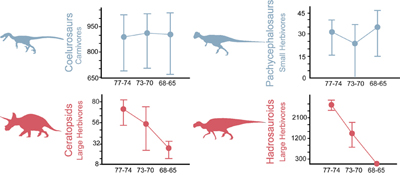Dinosaurs in decline long before mass extinction?
Despite years of intensive research focusing on the extinction of non-avian dinosaurs 65.5 million years ago, a fundamental question remains: were dinosaurs already undergoing a long-term decline before an asteroid hit at the end of the Cretaceous? A study led by scientists at the American Museum of Natural History (AMNH) and the GeoBio-Center gives a multifaceted answer.
07.05.2012

Disparity trends in four dinosaur groups during the final 12 million years of the Cretaceous (North American species only). Time (from 77-65 million years ago) is shown on the x axis. The y axis shows the disparity metric: sum of variances derived from anatomical character databases. The error bars indicate whether comparisons between time intervals are significant or not (overlap of error bars means non-significance, no overlap means significance). Overall, the large-bodied bulk-feeding ceratopsids and hadrosauroids underwent a marked long-term decline, but the carnivorous coelurosaurs and small herbivorous pachycephalosaurs were stable. (AMNH/S. Brusatte)
The research team calculated morphological disparity for seven major dinosaur groups using databases that include wide-ranging characteristics about the intricate skeletal structure of nearly 150 different species. They found that hadrosaurs and ceratopsids, two groups of large-bodied, bulk-feeding herbivores (i.e. animals that did not feed selectively) may have experienced a decline in biodiversity in the 12 million years before the dinosaurs ultimately went extinct. In contrast, small herbivores (ankylosaurs and pachycephalosaurs), carnivorous dinosaurs (tyrannosaurs and coelurosaurs), and enormous herbivores without advanced chewing abilities (sauropods) remained relatively stable, or even slightly increased, in biodiversity. As a complication, hadrosaurs showed different levels of disparity in different locations: While declining in North America, the disparity of this dinosaur group seems to have been increasing in Asia during the latest Cretaceous.
Overall, the results suggest a more nuanced picture of the final 12 million years of dinosaur history. Although large herbivores appear to have been declining within North America, this pattern is not seen in other groups or geographic regions. In North America, extreme fluctuations of the inland Western Interior Sea and mountain building might have affected the evolution of dinosaurs in distinct ways from species on other continents. The research team suggests that, therefore, the intensively studied North American record might not be representative of a global pattern, if such a global pattern exists.
Funding: Richard Butler is funded by a DFG Emmy-Noether Programme award.
Paper: Brusatte, SL, Butler, RJ, Prieto-Márquez, A & Norell, MA. 2012. Dinosaur morphological diversity and the end Cretaceous extinction. Nature Communications. Doi: 10.1038/ncomms1815

